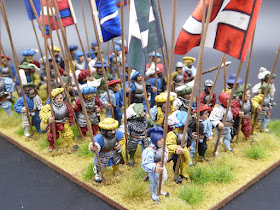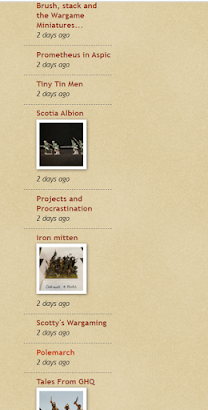Having acquainted myself with the Fields of Honor rules in the first outing of Action at Mill Creek, I figured the best way in which to reinforce what I learned was to reset the battlefield and try again before those lessons slipped away. That is what I did.
Initial deployments were as before with the Americans defending a bridge in an attempt to block an advancing British army. The Americans had at their disposal two Continental line regiments guarding the bridge, two militia and a battery on a hill overlooking the stream. Add to these forces, the possibility of up to three reinforcing Continental line regiments. The British had three brigades arrayed for the attack against the American positions.
 |
Initial deployments
|
Victory goes to the British commander if he can control both the bridge and have two regiments upon the hill without first suffering 50% casualties. In the first battle, the British saw a convincing victory by throwing the Americans back from the bridge and hill without exhausting its army. |
British ready to step off
|
Turn 1With the British as the aggressor, the redcoats act first. To begin the battle, both players roll on the Events Table. The Americans roll a Calamity Event. With the specific Calamity result dictated by a second die roll, the British commander is allowed to choose the event to befall the Americans. Out of Ammo is the chosen Calamity. The Continentals defending the bridge will be forced to check ammo availability every time they attempt to fire. Not a good start for the defenders.
The British begin their advance toward the American line. Out of musketry range for now, the Militia choose to place themselves under Hold (Op Fire marker in the photo) orders so that they may react once the British march into range.
Turn 2
The British continue to advance. The British gun, unlimbered toward the rear, targets the militia on the hill and causes one hit. The Continentals advance to the stream in order to contest the British advance. The 7th Pennsylvanians, defending the bridge, find the ammo to fire into the 4th Foot. One hit is suffered by the 4th.
 |
| Initial clashes begin |
To the left of the 7th Penn, the 4th Penn finds the ammo to unleash a devastating volley into the 49th Foot. The Pennsylvanians deal three hits into the redcoats. The 49th fails three morale checks and the unit is destroyed. Ouch! Rules note: A unit may absorb three hits before being eliminated. With each hit, the defender makes a Morale Check. Pass the Morale Check and no hit is registered. Fail and the unit keeps the hit.  |
Deadly volley into 49th
|
 |
49th destroyed
|
The American gun on the hill reaches out and touches the British 9th Foot for one hit. The British attack is not beginning well. |
Guns find a target
|
Turn 3The Americans suffer a second Calamity Event. This time, a British sniper takes down an American officer. Fortunately, he is only wounded. No command bonuses this turn.
 |
British ready for an attack against the American left
|
On the British left, converging fire finds its mark. The British Light Infantry, the 4th Foot, and the battery concentrate their fire onto the 7th Penn. Out of six hits from incoming fire, the stout Pennsylvanians manage to brush off four of those. Result is that the 7th Penn suffers two hits, still nearly wrecking it. Heavy casualties, for sure, but a unit can take three hits before becoming ineffective. The militia on the hill takes a second hit from the 9th. It, too, is on the verge of collapse.
 |
Concentrating fire onto the Pennsylvanians
|
With enemy upon its left, a battered friend upon its right and rear, the 4th Penn withdraws. The battered 7th Penn does likewise. On the brink of collapse, the militia falls back as well. To fill this void, Smallwood's regiment climbs up onto the heights. |
The 4th Penn is outflanked
|
 |
Much of the American line falls back
|
As Smallwood crests the hill, the weakened 9th foot is seen below. Surprised by the arrival of fresh reinforcements, the 9th Foot is scattered by Smallwood's volley.
 |
Smallwood fires into the 9th Foot
|
 |
9th foot is scattered
|
Turn 4
On the British left, both the Light Infantry and 4th Foot pour volleys into the 4th Penn. The Pennsylvanians suffer two hits. Now, both the 4th and 7th Penn are teetering on destruction.
 |
The American right is taking a beating
|
On the British right, the 24th and 17th Regiments of Foot go in against the militia on the heights. In brutal close combat, the militia are pushed off the hill in retreat having suffered two hits. The British take the heights. |
British attack the heights on the British right
|
 |
and succeed!
|
Having dispatched the 9th foot moments before, Smallwood comes off the heights to retake the bridge. With fire from both the wavering 4th Penn and his own regiment, Smallwood scatters the 4th Foot with seeming ease. The 4th Foot's commander falls from the saddle, dead. Control of the vital bridge is once again contested. |
Volleys pour into the 4th Foot
|
 |
and the 4th is destroyed.
|
Turn 5With one end of the heights secured, the British attack the American guns in the earthworks. Fighting their way into the earthworks, the 17th and 24th Foot suffer heavy casualties as the defenses and canister cause great destruction. While casualties on the guns are brutal, the British are thrown back. The redcoats retreat back down the hill.
 |
The British go in against the guns
|
On the British right, both wavering Pennsylvanian regiments are scattered as the British close in with aggression. Both Pennsylvanian regiments are destroyed. |
Heavy fighting on both flanks
|
On the British right, one of the American militia retakes the high ground.  |
Militia reclaim the heights
|
Turn 6With both sides sustaining powerful body blows to their forces, the battle appears in the balance. In the balance except that the British have lost four units including a general. The British 50% breakpoint is five units lost. The Americans, while holding the high ground with units badly beaten up, still have victory within their grasp. The British units control the bridge. If only one more British unit can be destroyed before losing the heights for a second time victory can be secured. In desperate firefights, the militia in the center is destroyed. Now three American units are lost. To push the British over the breakpoint, the remaining militia scores a hit against the 24th Foot. The 24th is destroyed. The Americans hang on for victory!
 |
Americans hold on!
|
The outcome of this contest came down to the wire. The Americans managed to push the British to the breakpoint but three of the remaining American units were one hit away from destruction. Very close result and a good test of the rules.
As for the rules, Fields of Honor offered up a quick playing game with only a few rules. A simple game, I think. With each unit having differing characteristics with respect to FIRE, CLOSE COMBAT, and MORALE, distinctions between the British line and its American counterparts came into play with little overhead. Militia cannot be expected to fight toe-to-toe with the British but they can get a lick or two in before being driven off.
Play for this contest was entirely off the QRS with no need to look up anything in the rules booklet. Even if I had referred to the book, it would not have taken long. The rules are only a few pages in length.
With FoH being at the Simple end of the gaming spectrum, I will use this replay to answer Steve's Allure of Simple Wargaming questionnaire. Those responses next time.
By the way, this was a great excuse (if one every really needs one) to get the 15mm AWI collection out of storage and onto the gaming table. It has been far too long, for sure. Hopefully, these troops will return to the table in the not too distant future.
















































